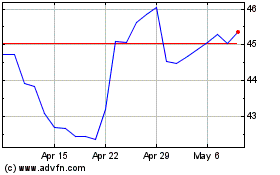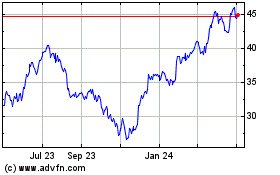GM's Operating Profit Hurt by China Results, U.S. Production Cuts -- 3rd Update
April 30 2019 - 5:51PM
Dow Jones News
By Mike Colias
General Motors Co. warned that weaker results from China will
continue to weigh on its bottom line this year as a lingering
slowdown in the world's largest vehicle market takes a toll on even
the biggest auto-industry players.
GM said Tuesday that income from China sank by more than
one-third in the first-quarter to $376 million, driving an 11%
decline in the company's overall operating profit. Chief Executive
Mary Barra said she sees "more downside than upside risk in the
near term" for China, where industrywide sales remain in their
first protracted decline in decades.
Ms. Barra said it is hard to predict if sales will rebound this
year because it is unclear whether Beijing will offer consumer
incentives to stoke new-vehicle demand, and buyers seem to be
holding off on purchases. The central government has encouraged
local authorities to offer stimulus, but so far hasn't taken direct
action to lift the auto sector.
"It's really key that we get some stability from the stimulus
measures," Ms. Barra told analysts during a conference call.
Auto-industry sales in China fell 3% last year and sank a
further 11% in the first quarter, transforming a once-reliable
source of growth into a trouble spot for global car companies. GM
is one of the top-selling car companies in China and earned about
$2 billion there last year as smaller rivals racked up losses, but
expects weaker results this year.
Overall, GM's operating profit for the January-through-March
quarter totaled $2.3 billion, down from $2.6 billion a year
earlier.
Operating earnings per share were $1.41, surpassing Wall Street
analysts' average estimate of $1.10 a share.
Those results were lifted 31 cents by revaluations of GM's
stakes in ride-hailing company Lyft Inc., which it took in early
2016, and French auto maker PSA Group. GM marked up the value of
its Lyft stake, which had climbed higher than what was previously
recorded on GM's books, after the ride-hailing company's initial
public offering in March.
GM finance chief Dhivya Suryadevara reiterated GM's full-year,
earnings-per-share forecast of $6.50-$7, versus $6.54 last
year.
The weakness in China puts more pressure on GM's business in
North America to drive future profit growth.
Operating profit from the company's home region fell 15% to $1.9
billion, hurt by a planned cut in factory production of highly
lucrative sport-utility models, such as the Chevrolet Suburban and
Cadillac Escalade. GM suspended production of the SUVs at its
factory in Arlington, Texas, to prepare the facility to make
versions scheduled to go on sale next year.
Ms. Suryadevara said the auto maker's results should accelerate
in the second half of the year, partly from the rollout of new
heavy-duty versions of its Chevy Silverado and GMC Sierra pickup
trucks.
GM is reaping stronger pricing in the U.S., especially on its
pickup trucks. This factor also helped lift the profit of rival
Ford Motor Co. , which posted first-quarter earnings last week.
Detroit auto makers dominate the market for big pickup trucks and
large sport-utility vehicles, categories that contribute the vast
majority of global profits for GM and Ford, analysts estimate.
A restructuring of its U.S. business also should help GM's
bottom line throughout the year, Ms. Suryadevara said. GM was the
subject of criticism from President Trump in March over the
company's closure of a factory in Lordstown, Ohio, part of a
broader plan that included thousands of salaried-worker layoffs in
the first quarter. The company expects the moves to help operating
profit by as much as $2.5 billion this year.
In a note to clients, Deutsche Bank analyst Emmanuel Rosner
called GM's results "mixed" but said he sees "material improvement
going forward as GM starts to realize the very large savings from
its restructuring efforts."
Ms. Barra has described the effort as a transformation of GM as
it pushes into new areas such as self-driving cars that are rife
with new competition from well-funded Silicon Valley newcomers. The
auto maker plans to spend $1 billion this year on its San
Francisco-based Cruise autonomous-car division, including doubling
its employee count to about 2,000 workers.
Ms. Barra was noncommittal, though, when asked by analysts
whether GM would meet a previously stated goal of rolling out an
autonomous ride-hailing service by the end of 2019. She said GM
likes its position relative to other players trying to
commercialize autonomous cars, but wouldn't confirm a 2019
launch.
"We expect to maintain the leadership position we are in now,"
she said. "Safety will be the priority."
Write to Mike Colias at Mike.Colias@wsj.com
(END) Dow Jones Newswires
April 30, 2019 17:36 ET (21:36 GMT)
Copyright (c) 2019 Dow Jones & Company, Inc.
General Motors (NYSE:GM)
Historical Stock Chart
From Mar 2024 to Apr 2024

General Motors (NYSE:GM)
Historical Stock Chart
From Apr 2023 to Apr 2024
